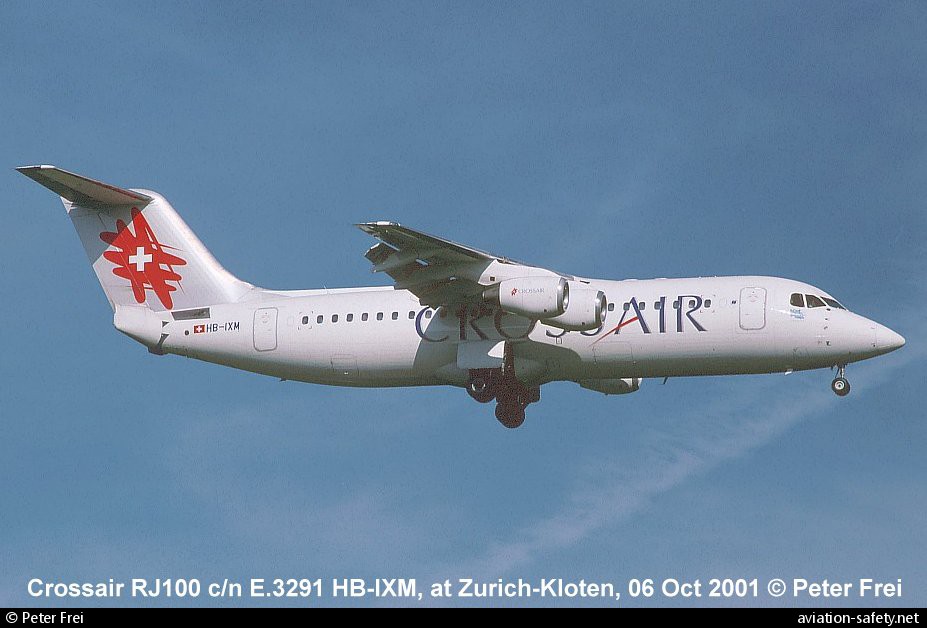
| Date: | Saturday 24 November 2001 |
| Time: | 22:06 |
| Type: |  Avro RJ100 |
| Owner/operator: | Crossair |
| Registration: | HB-IXM |
| MSN: | E3291 |
| Year of manufacture: | 1996 |
| Total airframe hrs: | 13194 hours |
| Cycles: | 11518 flights |
| Engine model: | Lycoming LF507-1F |
| Fatalities: | Fatalities: 24 / Occupants: 33 |
| Aircraft damage: | Destroyed, written off |
| Category: | Accident |
| Location: | 4 km E of Zürich-Kloten Airport (ZRH) -
 Switzerland Switzerland
|
| Phase: | Approach |
| Nature: | Passenger - Scheduled |
| Departure airport: | Berlin-Tegel Airport (TXL/EDDT) |
| Zürich-Kloten Airport (ZRH/LSZH) | |
| Investigating agency: | BFU Switz. |
| Confidence Rating: |
Flight 3597 departed Berlin-Tegel at 21:01 from runway 26L for a flight to Zürich. The Avro climbed to a cruising altitude of FL270. At 21:40 the crew were cleared to descend to FL240 and two minutes later further down to FL160. At that time the crew were carrying out an approach briefing for a runway 14 ILS approach at Zürich. Having been further cleared down to FL130, the crew were told to prepare for a runway 28 VOR/DME approach. Another approach briefing was carried out and the minimum descent altitude was found to be 2390 feet AMSL. At 21:58 the aircraft was cleared for the runway 28 approach.
At 22:03 the aircraft was descending to 4000 feet after which it turned right for the final approach to runway 28. At 22:04 a preceding aircraft reported having the runway in sight at 2.2DME. At about 22:05 the captain reported reaching the minimum descent altitude and said that he could see the ground. A little later the radio altimeter reported 500 feet agl, followed by a "minimum" warning. The captain then ordered a go around, but this was too late. The aircraft struck trees and crashed. The treetops were at 1784 feet AMSL.
On October 18, a treaty was signed between Switzerland and Germany a.o. regarding the use of German airspace for Zurich approaches at certain times of the day. After 10 p.m., incoming aircraft had to approach Zurich from the east to land on runway 28. While the other runways have ILS equipment, runway 28 only allows VOR/DME approaches. Over a two week period (9-22 November) 108 approaches were carried out on runway - 2,3% of the total number of landings for that period.
CAUSES: "The accident is attributable to the fact that on the final approach, in own navigation, of the standard VOR/DME approach 28 the aircraft flew controlled into a wooded range of hills (controlled flight into terrain - CFIT), because the flight crew deliberately continued the descent under instrument flight conditions below the minimum altitude for the approach without having the necessary prerequisites. The flight crew initiated the go around too late. The investigation has determined the following causal factors in relation to the accident:
- The commander deliberately descended below the minimum descent altitude (MDA) of the standard VOR/DME approach 28 without having the required visual contact to the approach lights or the runway
- The copilot made no attempt to prevent the continuation of the flight below the minimum descent altitude.
The following factors contributed to the accident:
- In the approach sector of runway 28 at Zurich airport there was no system available which triggers an alarm if a minimum safe altitude is violated (minimum safe altitude warning - MSAW).
- Over a long period of time, the responsible persons of the airline did not make correct assessments of the commanders flying performance. Where weaknesses were perceptable, they did not take appropriate measures. The commanders ability to concentrate and take appropriate decisions as well as his ability to analyse complex processes were adversely affected by fatigue.
- Task-sharing between the flight crew during the approach was not appropriate and did not correspond to the required procedures by the airline.
- The range of hills which the aircraft came into contact with was not marked on the approach chart used by the flight crew.
- The means of determining the meteorological visibility at the airport was not representative for the approach sector runway 28, because it did not correspond to the actual visibility.
- The valid visual minimums at the time of the accident were inappropriate for a decision to use the standard VOR/DME approach 28."
METAR:
19:20 UTC / 20:20 local time:
LSZH 241920Z 16001KT 4500 -SN FEW010 OVC025 00/M00 Q1024 8829// // TEMPO 3000=
21:20 UTC / 22:20 local time:
LSZH 242120Z 13002KT 4000 -SN FEW006 BKN015 01/M00 Q1023 8820// 99 NOSIG=
Accident investigation:
 |
|
Sources:
SKYbrary
Location
Images:

photo (c) Peter Frei; Zürich-Kloten Airport (ZRH); 06 October 2001
Revision history:
| Date/time | Contributor | Updates |
|---|
The Aviation Safety Network is an exclusive service provided by:


 ©2024 Flight Safety Foundation
©2024 Flight Safety Foundation